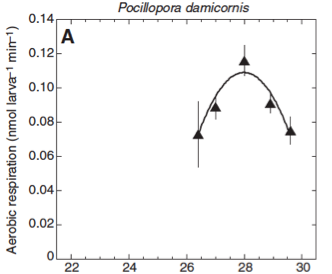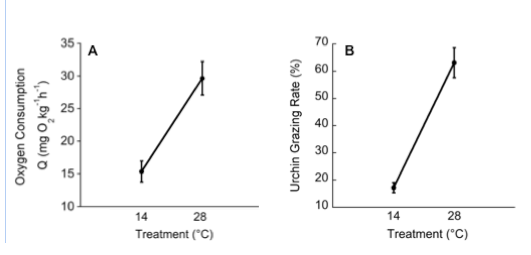This is the fourth installment of my serialization of a new book chapter on “Climate Change and Marine Communities” written with Chris Harley and Mike Burrows. It is for a new book “Marine Community Ecology and Conservation” that I’m co-editing with Mark Bertness, Brian Silliman, and Jay Stachowicz. The book is more or less a followup to the best-selling 2001 edition (which is out of print and worth $100 used and $500 new at Amazon!). We asked our authors to tell us what has happened over the last 10 years in their assigned subfield. The chapters are amazing. And I am truly blown away by how much we’ve discovered since the publication of the first edition! Many fields have been revolutionized and many-a-paradigm has been overturned. Cool stuff.
Individual-level effects of ocean warming: ecophysiology
Temperature directly affects organismal physiology and performance through its control of the rate of biochemical reactions. Temperature determines diffusion rates and enzyme kinematics, which in turn control the reaction rates for enzyme-driven biological activity. Typically, warming increases the rates at which enzymes encounter and bind with substrate molecules, thereby increasing the rate of enzyme-catalyzed reactions, however, when temperatures become too high, the enzymes themselves become damaged, and reaction rates drop. The resulting thermal response curve for enzyme activity is therefore unimodal, with an accelerating rise from low temperatures up to some thermal optimum, and then an increasingly steep drop-off once the optimum temperature has been exceeded. Due to these fundamental biochemical constraints, metabolic rate has a similar relationship with temperature (Fig 5). For marine ecotherms like invertebrates and most fishes, warming up to a point means higher metabolism, increased energetic demands, and a variety of other life history changes (Kordas et al. 2011).
 Figure 5. Temperature effects on respiration of larvae of the coral Pocillopora damicornis. From Edmunds et al 2011.
Figure 5. Temperature effects on respiration of larvae of the coral Pocillopora damicornis. From Edmunds et al 2011.
The temperature dependence of fundamental biological processes like metabolism, photosynthesis, and life span are formally unified under the Metabolic Theory of Ecology (Brown et al. 2004). MTE is based on biophysical principles and is useful for predicting how biological activity scales with body mass and temperature. MTE can also be used to predict and understand the primary and secondary effects of natural spatial and temporal variation in temperature as well as those of anthropogenic global warming (O’Connor et al. 2011b). For example, increasing water temperature from 14°C to 28°C roughly doubles oxygen demand (Fig. 6A) by the green sea urchin Lytechinus semituberculatus, a common herbivore on shallow, subtidal reefs in the Galapagos Islands where temperature swings of that magnitude can occur among seasons and years. And as predicted by theory (O’Connor et al. 2011a), warming-induced increases in metabolism cause a four fold increase in grazing rate (Fig. 6B), which could affect standing algal biomass and thus a number of ecosystem attributes. Thus temperature modifies not only the metabolism of individuals but also their ecosystem function (Sanford 1999).
Figure 6. Temperature effects on (A) metabolism of the urchin Lytechinus semituberculatus measured as urchin oxygen consumption, and (B) the rate of consumption of the green alga Ulva sp. by the urchins. Values are means ± SE. Based on laboratory mesocosm measurements from Carr and Bruno in review.
The Literature Cited for the entire chapter is here as a PDF

Leave a Reply